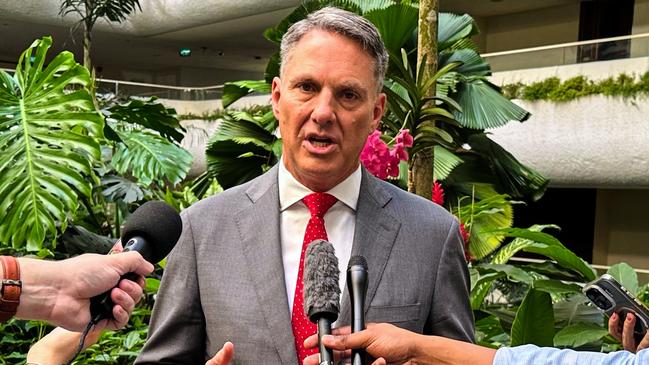
After being spectacularly called out by the Trump administration over its go-slow increase in defence spending, the Albanese government now faces a dilemma of its own making about how to respond.
US Defence Secretary Pete Hegseth has deliberately provoked Australia by publicly stating the Trump administration wants a dramatic increase in spending from 2 per cent of GDP to 3.5 per cent.
Hegseth did not need to reveal this request publicly, but chose to do so in order to increase pressure on Australia to lift its contribution to regional and global security.
Indeed Defence Minister Richard Marles tried to hide the specifics of their meeting in Singapore by failing to mention the 3.5 per cent figure to Australian media.
Why was Marles so shy? Because it now puts the Albanese government in a very awkward spot – a spot for which it alone is responsible.
If the government rushes to increase defence spending now, it risks being seen as a lackey of Trump and would make a lie of Albanese’s insistence that “we’ll determine our defence policy”.
Yet to do nothing and completely ignore the requests of our closest ally – a country which is asking all of its allies to step up around the world – makes Australia appear like a laggard on collective global security at a time of grave strategic uncertainty.
Such a vocal call-out by the Trump administration would not have been necessary if the government had done the right thing before the election and pledged a meaningful increase in defence spending.
The government knows that Australia faces the worst strategic circumstances in generations – because it says so itself – and it knew that Trump was berating his European allies for not spending more on defence.
So the right thing to do was to be proactive and announce a sizeable long-term commitment to higher defence spending before Trump called for it.
Labor strategists will say smugly that they won the election in a canter so they were right in their judgment that there was no public clamour to lift defence spending beyond current commitments.
But doing what’s right for national security isn’t always about what polls or focus groups think.
A grown-up government puts national interests ahead of its own budget handouts and short-term political strategy.
The best model for how Australia should respond now is British Prime Minister Keir Starmer, who this year responded to what he calls a “generational” challenge to security by pledging to lift Britain’s defence spending from 2.3 per cent of GDP to 2.5 per cent in just two years with a “clear ambition” to lift it to 3 per cent of GDP after the next election.
There is no reason why Australia cannot commit to lifting defence spending sharply from its current 2.02 per cent of GDP to 2.5 per cent by the end of the decade with an aspiration to raise it to 3 per cent in the 2030s.
This would be a meaningful increase and one which will be needed anyway to pay for the eye-watering costs of the AUKUS pact fleet of nuclear-powered submarines.

Almost every serious national security commentator in the country says 3 per cent is necessary to meet the challenge of a rising China and to pay for the future defence force which the government has promised.
Hegseth’s proposed level of 3.5 per cent of GDP is probably a stretch too far – it is unlikely to happen in peacetime Australia without a fundamental rethinking of the social compact of government. But there is no reason why the government cannot work towards the still-ambitious 3 per cent target.
The government boasts about how it is injecting $10bn in new money into defence over the next decade to lift defence spending from around 2 per cent to 2.3 per cent in 2033-34.
But this is sleepwalking compared to much of the rest of the Western world and is still below almost all of its like-minded European counterparts from Britain (2.3) to Poland (4.1), Greece (3.1), Denmark and Finland (2.4). Norway, Sweden, Turkey and France all spend more than Australia now does on defence as a proportion of GDP.
The Prime Minister appears frustrated by the pressure from the US and is so far downplaying its significance.
But the government knows it needs to step up its defence spending, not just because of Trump, but because of the growing shadow being cast by China.
This government almost certainly has six years left in power – now is the time to do the right thing, not just the easy thing, on defence and security.






